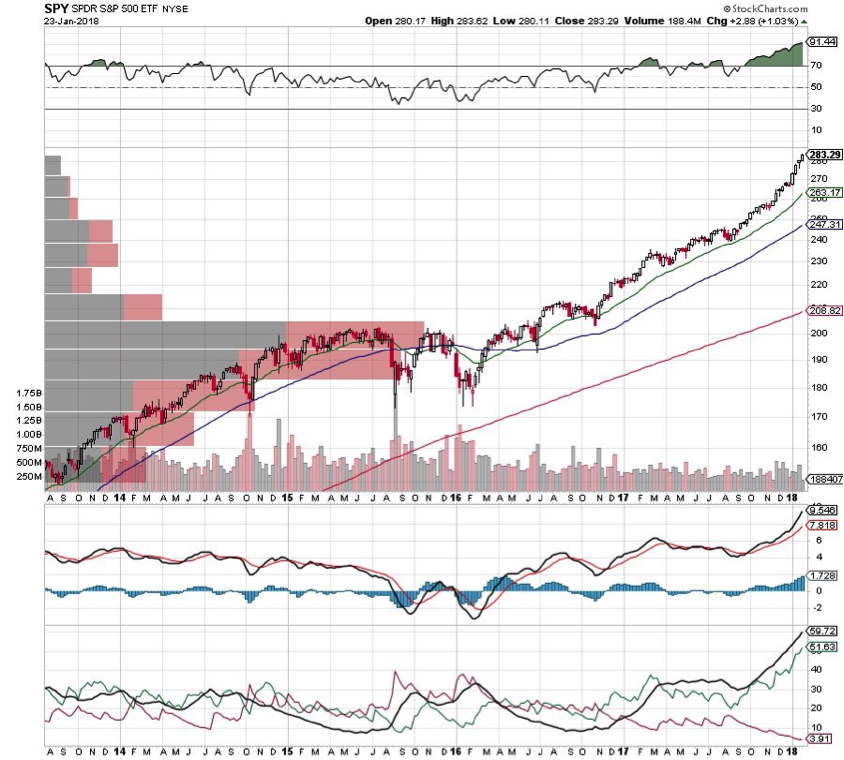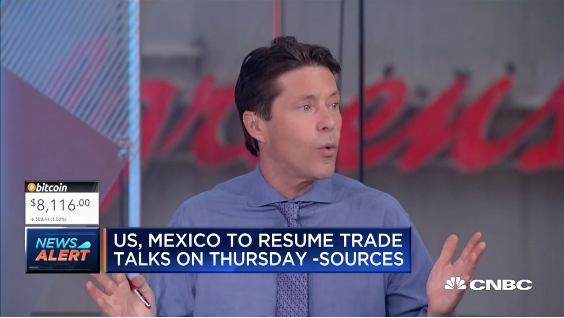Here’s a chart you soon won’t forget. The decline of the USD has been yet another reason supporting equity prices of late. The dollar is suffering another selloff on Wednesday with a key dollar index falling to a three-year low after U.S. Treasury Secretary Steven Mnuchin said a weaker greenback is good for trade.

The dollar has been steadily falling since peaking in June of 2017. The greenback was put under more selling pressure after Mnuchin in Davos said he wasn’t concerned about the currency’s recent stumble. Additionally, Mnuchin said a weaker greenback “is good for us as it related to trade and opportunities,” breaking with the usual strong dollar policy.
Yesterday’s trading found the Dow Industrial Average basically flat with both the S&P 500 and Nasdaq achieving new record levels. The major averages have been on a record pace with the S&P 500 achieving its longest ever period of gains without a 5% pullback. The strength of the S&P 500 can be viewed in the Relative Strength Index, which hit 94 in Tuesday’s trade before finishing the day at 91.44. Simply remarkable as indicated in the chart below.

The RSI is a widely used technical indicator originally proposed by J. W. Wilder in the book New Concepts in Technical Trading Systems, published in 1978. The value of the RSI provides information on the direction and magnitude of price movements. The RSI varies from 0 to 100, with values below 50 indicating prices declining and values above 50 indicating prices increasing. To determine the RSI value from a given time series of closing prices (hourly, daily, weekly, monthly, etc.), the relative strength (RS) is first calculated from: RS = Average percent gain / Average percent loss.
When we review the technicals going back some 10 years on the S&P 500 we come to also understand that the most recent readings from the RSI are supported by a technical breakout.

That is generally what one should expect from such overbought conditions, a breakout of a 10-year channel. Again, simply a remarkable run for the S&P 500! If you thought that such overbought conditions would spell an impending downturn in markets or the S&P 500, that’s not necessarily what these analysts suggested on CNBC the other day. The S&P 500’s 14-month relative strength index (RSI) surpassed the 87 level for the first time in nearly 22 years before climbing above 90 the same day.
“There’s really two key takeaways,” said Wald. “One, even when you got to those high RSI readings, it was still followed by above-average returns. Two, that RSI indicator peaked at least a year ahead of the market on all those occasions, said Ari Wald, head of technical analysis at Oppenheimer, told CNBC’s Trading Nation.
Switching focus to cryptocurrencies for a moment, the most outspoken bull on the complex talked his book, also on CNBC. China and South Korean authorities and governments regulating the complex has sent the crypto-complex lower in recent weeks, but CNBC’s Brian Kelly says that investors might find this an optimal period for investors to scoop up bitcoin.
“The flows have not stopped.”
“This is not the end of bitcoin,” Kelly said, warning investors that buying the extremely volatile asset when prices are high can be dangerous.
“When we talk about bitcoin being up at $20,000, everyone is running around being all excited,” he said. “Those are the times to be a little cautious.”
Kelly also offered 3 main rules when investing in bitcoin as follows:
- Only risk 1 percent to 5 percent of assets.
“This is a new technology,” said Kelly. “Things break. This is the internet in 1995.”With an asset that fluctuates in price so much, the potential for growth is exponential — but so is the loss. If the investment doesn’t work out, losses can easily be absorbed, Kelly pointed out.
- Don’t sell too soon.
Kelly recommended holding on to the currency, even if it’s up 20 percent or 30 percent. “Once there’s momentum, you hold onto this thing,” he said.
- Do not panic when coin drops 50 percent.
Understand the volatile nature of digital currency. “These things can move 20 percent to 30 percent in a day, said Kelly.
Of course, this more recent commentary by Brian Kelly contradicts statements made by the big financial institutions like JP Morgan Chase and Bank of America. Bank of America CEO Brian Moynihan stated the following about cryptocurrencies after the company banned financial advisors from buying bitcoin-related investments for their clients.
“We have limited our relationships,” Moynihan said about cryptocurrencies in a media call. “We basically told people they could buy at other accounts, not at Merrill Lynch.”
I personally can’t find the logic for investing in an asset class that I don’t fundamentally understand. While I understand block chain technology underlying bitcoin, the two are commingled into an investment for which has yet to find mainstream adoption. Certainly there is the element of “missing the boat” that bemoans the pundits warnings on the crypto currency complex, but until the complex finds mass adoption it should be expected. Believers and non-believers will find a voice that aligns with the daily, weekly and monthly price swings that litter the crypto currency complex.
Now let’s talk a little General Electric which has been discussed at length since announcing broad restructuring efforts late last year. The stock price has been on a rocky road as of late as a battle between value investors and doomsdayers layer into the name on both sides. But shares soared 4.5% Tuesday, the biggest one-day percentage gain since Oct. 5, 2015, to snap a six-session losing streak. The stock had closed Monday at $16.17, the lowest close since Dec. 2, 2011.
Last week, GE said it would book a $6.2 billion charge to its fourth-quarter earnings, citing weakness in its North American Life & Health insurance portfolio. The company also said that its financing arm GE Capital would make $15 billion in payments over the next seven years to shore up NALH’s statutory reserves, starting with around $3 billion in the first quarter of this year, and approximately $2 billion annually from 2019 to 2024. Lastly, the company also said that GE Capital will also suspend its dividend to GE “for the foreseeable future.
Given all of these net negative announcements from GE, analysts have further soured on the company’s prospects including, Bank of America Merrill Lynch analysts Andrew Obin.
“We now believe that GE is likely to cut its 2018 outlook when it reports fourth-quarter earnings on Jan. 24, as we estimate that Power was the key driver of its lower fourth-quarter outlook,” the analysts wrote in a Jan. 22 research note.
Bank of America Merrill Lynch lowered its estimates for 2018 from $1.00 to 92 cents, as well as its 2019 forecast from $1.08 to $1.02.
GE is expected to report earnings, excluding nonrecurring items, of 29 cents a share, according to the average estimates of 14 analysts surveyed by FactSet. That compares with 46 cents a share in the same period a year ago, and has fallen from a FactSet consensus of 34 cents just three months ago. That FactSet revenue consensus is $33.87 billion, up from $33.09 billion a year ago, but down from a consensus of $34.40 billion three months ago.
U.S. equity futures are, you guessed it, once again higher heading into Wednesday’s trading day. Crude is roughly flat in early trading with the 10-year Treasury holding its yield steady above 2.62 percent. We’re set up for another interesting trading day that may ind the major indexes achieving more record levels.
Tags: GE SPY









